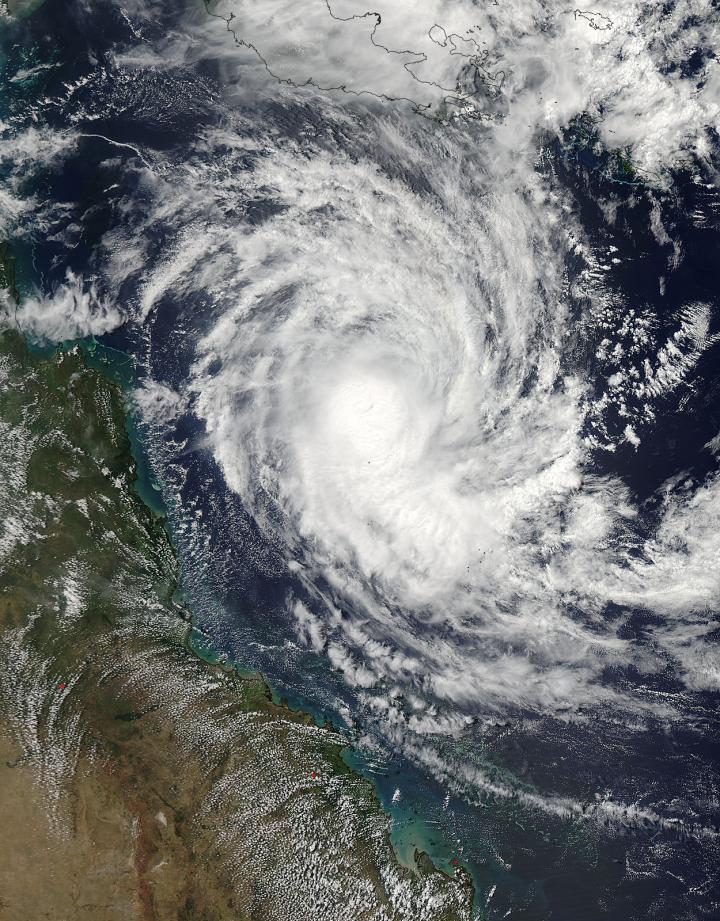NASA eyes Tropical Cyclone Nathan's Australian comeback

NASA's Aqua satellite captured this image of Tropical Cyclone Nathan still lingering off the east coast of Queensland, Australia on March 17, 2015. Image Credit: NASA Goddard MODIS Rapid Response Team
Two instruments aboard Aqua, MODIS and AIRS captured data on Nathan as it was tracking back toward Queensland. The Moderate Resolution Imaging Spectroradiometer or MODIS instrument captured a visible image of Nathan on March 17 at 03:35 UTC (March 16 at 11:35 p.m. EDT).
Nathan appeared to have strong thunderstorms around the center with a band of thunderstorms wrapping into it from the south.
The Atmospheric Infrared Sounder or AIRS instrument gathered infrared data on Nathan. Infrared data shows temperatures, and the colder the cloud top temperatures, the higher the thunderstorms that make up the tropical cyclone.
The cloud top temperatures around Nathan's center were near -63F/-52C, indicating strong storms with potential for heavy rainfall. The thunderstorms wrapping into the center from the south appeared to be a fragmented band.
At 0900 UTC (5 a.m. EDT), Tropical cyclone Nathan had maximum sustained winds near 45 knots (51.7 mph/83.3 kph). Nathan had moved south-southwest at 2 knots (2.3 mph/3.7 kph) and was centered near 14.6 south latitude and 149.5 east, about 254 nautical miles (292 miles/ 470 km) north-northeast of Cairns, Australia.
Forecasters at the Joint Typhoon Warning Center (JTWC) expect Nathan continue a slow crawl and slowly intensify to 75 knots, as it moves west. The Australian Bureau of Meteorology (ABM) forecast now calls for Nathan to make landfall in Queensland between Cooktown and Cairns around 10 a.m. local time on March 20.
ABM has not yet issued warnings, but posted a tropical cyclone watch from Cape Melville to Cardwell. ABM noted “gales may develop in the 24 to 48 hour period between Cape Melville and Cardwell, most likely late on Thursday afternoon or evening.
Coastal residents between Cape Melville and Cardwell are specifically warned of the possibility of a dangerous storm tide as the cyclone crosses the coast.” For updated forecasts from ABM, visit: http://www.
Media Contact
All latest news from the category: Earth Sciences
Earth Sciences (also referred to as Geosciences), which deals with basic issues surrounding our planet, plays a vital role in the area of energy and raw materials supply.
Earth Sciences comprises subjects such as geology, geography, geological informatics, paleontology, mineralogy, petrography, crystallography, geophysics, geodesy, glaciology, cartography, photogrammetry, meteorology and seismology, early-warning systems, earthquake research and polar research.
Newest articles

“Nanostitches” enable lighter and tougher composite materials
In research that may lead to next-generation airplanes and spacecraft, MIT engineers used carbon nanotubes to prevent cracking in multilayered composites. To save on fuel and reduce aircraft emissions, engineers…

Trash to treasure
Researchers turn metal waste into catalyst for hydrogen. Scientists have found a way to transform metal waste into a highly efficient catalyst to make hydrogen from water, a discovery that…

Real-time detection of infectious disease viruses
… by searching for molecular fingerprinting. A research team consisting of Professor Kyoung-Duck Park and Taeyoung Moon and Huitae Joo, PhD candidates, from the Department of Physics at Pohang University…




















